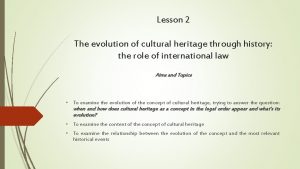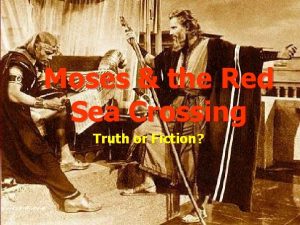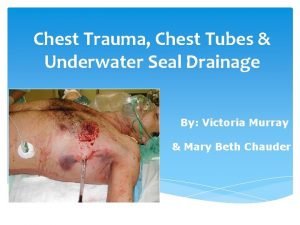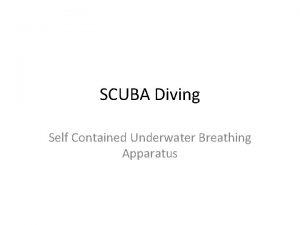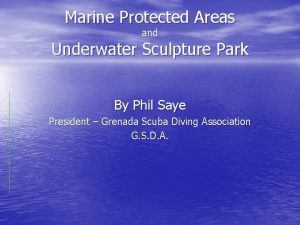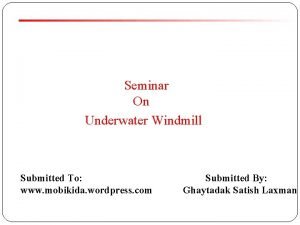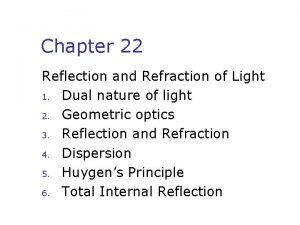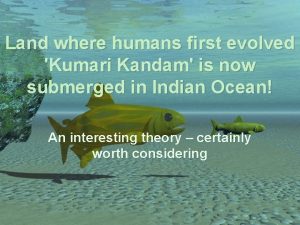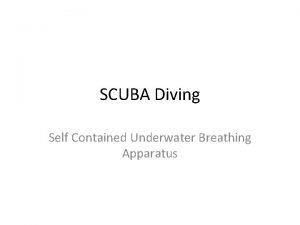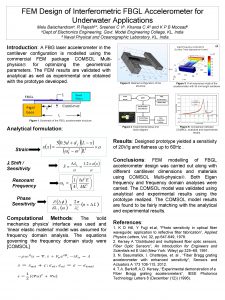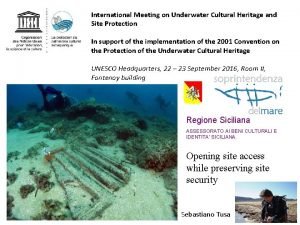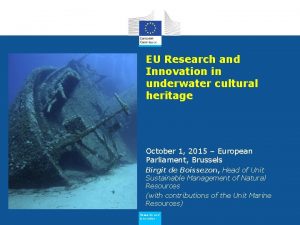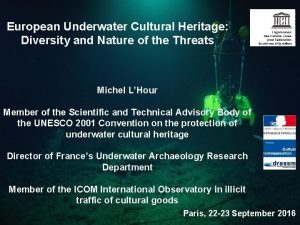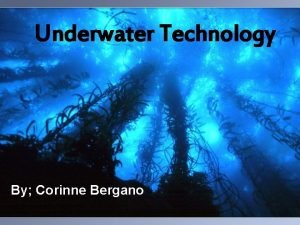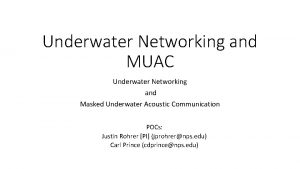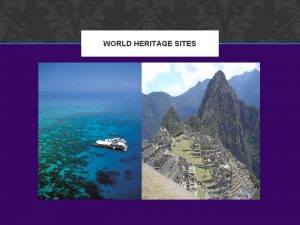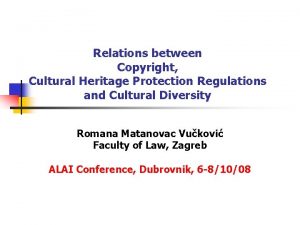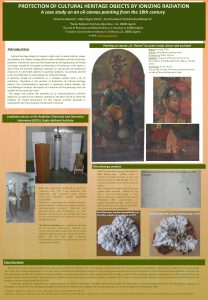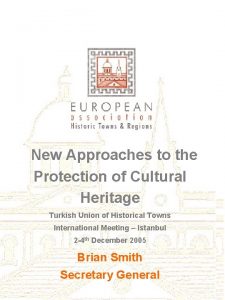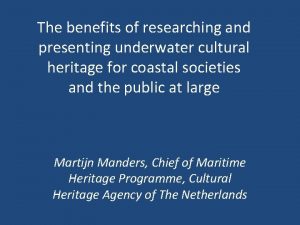The Legal Protection of Underwater Cultural Heritage The

































- Slides: 33

The Legal Protection of Underwater Cultural Heritage The UNESCO 2001 Convention on the Protection of the Underwater Cultural Heritage (UCH)

Why is Legal Protection Necessary? • The first step in effective heritage protection is legal protection • Certain national laws and preexisting international law do not comprehensively protect underwater cultural heritage

Why are National Laws Insufficient? • Many national laws do not yet protect underwater cultural heritage, or do so in a way that may favor commercial interests over heritage protection. • National laws, in general, do not apply outside the national territory

The Limits of National Laws at Sea • Territorial Sea & Contiguous Zone – States have full jurisdiction • Exclusive Economic Zone past the Contiguous Zone – States have limited jurisdiction • High Sea and the Area – States only have jurisdiction over their own citizens and flag vessels

The Solution under International Law • International law offers a way to protect cultural heritage outside the limits of national jurisdiction • States can enter into a treaty, for example, a convention, to solve issues of common concern, and to establish a system of mutual cooperation • The text of a convention is agreed upon by negotiation, and may be finalized by the signature of all involved States. Alternatively, the text may be adopted by a diplomatic conference • There are several ways in which States may be bound by a convention, such as ratification, accession or adoption.

International Law and UCH The most relevant international treaties for underwater cultural heritage are: • The United Nations Convention on the Law of the Sea (Montego Bay, 1982)– global treaty on jurisdiction at sea; only marginally touches upon underwater cultural heritage • UNESCO 2001 Convention on the Protection of the Underwater Cultural Heritage (Paris, 2001) – global treaty specifically dealing with underwater cultural heritage • Bilateral treaties (e. g. The Agreement Regarding the Shipwrecked Vessel RMS Titanic (London, 2003)) and regional treaties (e. g. European Convention on the Protection of the Archaeological Heritage (Valletta, 1992)) also exist

The United Nations Convention on the Law of the Sea

UNCLOS • Global Treaty on the rights and responsibilities of nations in their use of the world's oceans, establishing guidelines for businesses, the environment, and the management of marine natural resources • 50 years of negotiations • Entered into force in 1994 • More than 160 States Parties and the EU

UNCLOS • UNCLOS contains only two regulations on underwater cultural heritage (Articles 149 and 303) • These provide protection up to the limits of the contiguous zone, are very general and permit commercial salvage • In particular, Article 303 para. 3 stipulates that “Nothing in this article affects … the law of salvage …”

UNCLOS Article 149 Archaeological and Historical Objects “All objects of an archaeological and historical nature found in the Area shall be preserved or disposed of for the benefit of mankind as a whole, particular regard being paid to the preferential rights of the State or country of origin, or the State of cultural origin, or the State of historical and archaeological origin. ”

UNCLOS Article 303 Archaeological and Historical Objects Found at Sea “ 1. States have the duty to protect objects of an archaeological and historical nature found at sea and shall cooperate for this purpose. 2. In order to control traffic in such objects, the coastal State may, in applying article 33 [on the Contiguous Zone], presume that their removal from the seabed in the zone referred to in that article without its approval would result in an infringement within its territory or territorial sea of the laws and regulations referred to in that article. 3. Nothing in this article affects the rights of identifiable owners, the law of salvage or other rules of admiralty, or laws and practices with respect to cultural exchanges. 4. This article is without prejudice to other international agreements and rules of international law regarding the protection of objects of an archaeological and historical nature. ”

The UNESCO 2001 Convention

What is UNESCO • The United Nations Educational, Scientific and Cultural Organization, the only UN agency specializing in the protection of cultural heritage • Forum for international exchange and cooperation • Headquarters in Paris, 59 Field Offices around the world • Provides the secretariat of the 2001 Convention

Why a Convention at UNESCO? • One of the basic functions of UNESCO is the elaboration of standard-setting instruments • It provides the secretariat for 6 Culture Conventions • Works for comprehensive protection of all forms of heritage

The 2001 Convention • Adopted by the UNESCO General Conference in 2001 • Represents the response of the international community to the destruction of submerged archaeological sites • Ensures the same level of protection for underwater cultural heritage as that accorded to cultural heritage on land

The Content of the Convention • The 2001 Convention: • Harmonizes the protection of underwater cultural heritage with that of cultural heritage on land • Guarantees cooperation among States, and also among scientists worldwide • Promotes underwater archaeology, and sets a high standard for archaeological research • It contains: • • • Ethical principles Strong site protection measures A State cooperation mechanism Scientific guidelines for underwater archaeology (The Annex) No regulations regarding the ownership of heritage or national jurisdiction at sea • The Convention is in absolute harmony with UNCLOS (Art. 3).

The Definition of Underwater Cultural Heritage The Convention defines underwater cultural heritage as: ‘all traces of human existence having a cultural, historical or archaeological character which have been partially or totally under water, periodically or continuously, for at least 100 years’ (Art. 1)

The Definition and Scope • Provides blanket protection for underwater cultural heritage (No register or list system to define which sites are protected) • Does not discriminate based on the ‘significance’ of a site • The 100 year benchmark can be lowered in national legislation to include more recent sites • Protects not only sites, but also their context and all artefacts, even collections of nearly identical artefacts such as coins or dishware • Applies in all territories and to all persons under the jurisdiction the States Parties • This includes all flag vessels of the States Parties and all nationals of the States Parties • In some cases, jurisdiction also extends to the wrecks of vessels owned by the States Parties, regardless of the location of the wreck • Applies in all state waters, including inland bodies of water, such as lakes, rivers and swamps

Ethical Principles • States Parties must protect their underwater cultural heritage • The commercial exploitation and salvage of underwater cultural heritage is forbidden • In situ preservation shall always be considered as the first option, unless there is a good reason to recover heritage (i. e. protection, research or public education) • Responsible public access to underwater cultural heritage is encouraged • States Parties must ensure that proper respect is given to human remains on underwater cultural heritage sites

State Cooperation Mechanism • In international waters (not in territorial waters): • States Parties request that their nationals report discoveries and activities directed at underwater heritage • They share this information with the other States Parties through UNESCO • States may declare their interest to be consulted in regards to particular sites, and decide together on a course of action

Anti-Pillaging Measures • States Parties must prevent the entry, sale, or possession of illicitly or unethically recovered underwater cultural heritage within their territory • States Parties must prevent any part of their territory (e. g. ports or islands) from being used to support activities directed at underwater cultural heritage that do not conform with the Convention • States Parties are required to seize and manage underwater cultural heritage within their territory that has been recovered in a way that does not conform with the Convention • States Parties are required to impose sanctions against those who violate the Convention

Immunity of Warship Wrecks • There is no unanimity among States regarding the jurisdiction of the wrecks of state vessels, such as warships; this depends on national legislation. • The 2001 Convention does not provide for the jurisdiction of the States Parties over the wrecks of their state vessels, nor does it exclude it. The Convention does not regulate this issue, other than by providing protection to all kinds of wrecks. • The Convention does require that the flag state be notified of activities directed at the wrecks of its state vessels in the territorial waters of other States Parties • In international waters, the flag state must agree to any activities directed at the wrecks of its state vessels

Scientific Guidance – The Annex • The Annex of the Convention contains rules for activities directed at underwater cultural heritage • They are ethical and scientific guidelines for underwater archaeological research • They also describe the content and format of a project design • A detailed manual is available to complement the rules (http: //www. unesco. org/culture/en/underwater/pdf/UCHManual. pdf).

Relation to other UNESCO Conventions • World Heritage Sites under water: Bikini Atoll; Red Bay wrecks; Pile dwelling sites • Intangible Heritage connected to underwater heritage: Hawaii fish trap veneration; maritime rites; boat building techniques, such as the watertight-bulkhead technology of Chinese junks

Advantages of Ratification • The Convention provides effective guidelines on how to protect, intervene with and research underwater cultural heritage sites • It protects sites from pillaging and commercial exploitation, no matter where they are located, with the same level of protect provided to sites on land • Allows States to adopt a common approach and benefit from cooperation with other States. • Provides support to States Parties through the Scientific and Technical Advisory Body, a group of 12 experts in underwater archaeology

How to Ratify • Ratification is the declaration of a State to be bound by a convention (approval, accession and acceptance have the same effect) • The UNESCO 2001 Convention is ratified by the deposition of a ratification instrument (letter) with the UNESCO Director. General • Internal harmonization of national law with the Convention is often needed

How does the Convention function? State Parties make decisions The Meeting of States Parties directs the work of the States Parties through biannual meetings The Operational Guidelines give details on the implementation of the Convention. 11 accredited NGOs cooperate The Scientific and Technical Advisory Body advises the meeting in UNESCO provides the Secretariat scientific matters and best practices (annually at UNESCO Paris). It consists of 12 expert members appointed by and representing the States Parties Leading Universities are associated through a University Twinning (UNITWIN) network on underwater archaeology

UNESCO’s Operational Work

Operations • Improvement of Legal Protection: • The UNESCO 2001 Convention • Assistance in adapting and harmonizing national laws with the Convention (A Model Law available as an example) • Database of National Cultural Heritage Laws • Scientific Support: • Support for activities directed at underwater cultural heritage from the Scientific and Technical Advisory Body • Conferences on underwater heritage and underwater archaeology • Assistance in museum development • UNITWIN Network brings together leading universities in underwater archaeology • Leading NGOs are accredited by UNESCO

Capacity Building • Training is organized by HQ and field offices worldwide • UNESCO has trained more than 400 professionals from more than 80 States since 2007 in numerous courses of up to 3 months © UNESCO Training course in Cuba

Publications www. unesco. org/en/underwater-cultural-heritage

Awareness Raising • • • 7 -language website on underwater cultural heritage Kids webpage and cartoons Film on underwater heritage and the 2001 Convention Exhibitions on underwater heritage Encouraging States to make their underwater cultural heritage sites more accessible © UNESCO Exposition in Bangkok, Thailand

UNESCO Contact: Ulrike Guérin, UNESCO Convention on the Protection of the Underwater Cultural Heritage (2001) 7, place de Fontenoy, 75352 Paris 07 SP France Tel: + 33 1 45 68 44 06 Email: u. guerin@unesco. org Web: www. unesco. org/en/underwater-cultural-heritage
 World heritage is our heritage slogan
World heritage is our heritage slogan Sapratibandha
Sapratibandha Classification of property law
Classification of property law Intangible cultural heritage and sustainable development
Intangible cultural heritage and sustainable development Hudhud chants of the ifugao threats
Hudhud chants of the ifugao threats The second rome
The second rome Cultural heritage meaning
Cultural heritage meaning Cultural heritage advisors
Cultural heritage advisors Primerica prepaid legal
Primerica prepaid legal Consumer purchasing strategies and legal protection
Consumer purchasing strategies and legal protection Ice age scrat underwater
Ice age scrat underwater Red sea chariot wheels
Red sea chariot wheels Deep underwater
Deep underwater Bicmos technology seminar report
Bicmos technology seminar report Southern cross cable tonga
Southern cross cable tonga Baalzephon
Baalzephon Ccc underwater engineering
Ccc underwater engineering Underwater construction techniques
Underwater construction techniques Underwater seal drainage
Underwater seal drainage Self contained underwater breathing apparatus
Self contained underwater breathing apparatus Underwater sculpture
Underwater sculpture Eg&g underwater camera 1960
Eg&g underwater camera 1960 Underwater windmill
Underwater windmill An underwater scuba diver sees the sun
An underwater scuba diver sees the sun Continental margin
Continental margin Principles of underwater seal drainage
Principles of underwater seal drainage Kumari kandam underwater images
Kumari kandam underwater images How to draw sand underwater
How to draw sand underwater Self contained underwater breathing apparatus
Self contained underwater breathing apparatus Underwater accelerometer
Underwater accelerometer Ocean
Ocean Underwater frisbee
Underwater frisbee Local area orientation dive
Local area orientation dive Underwater habitat
Underwater habitat






